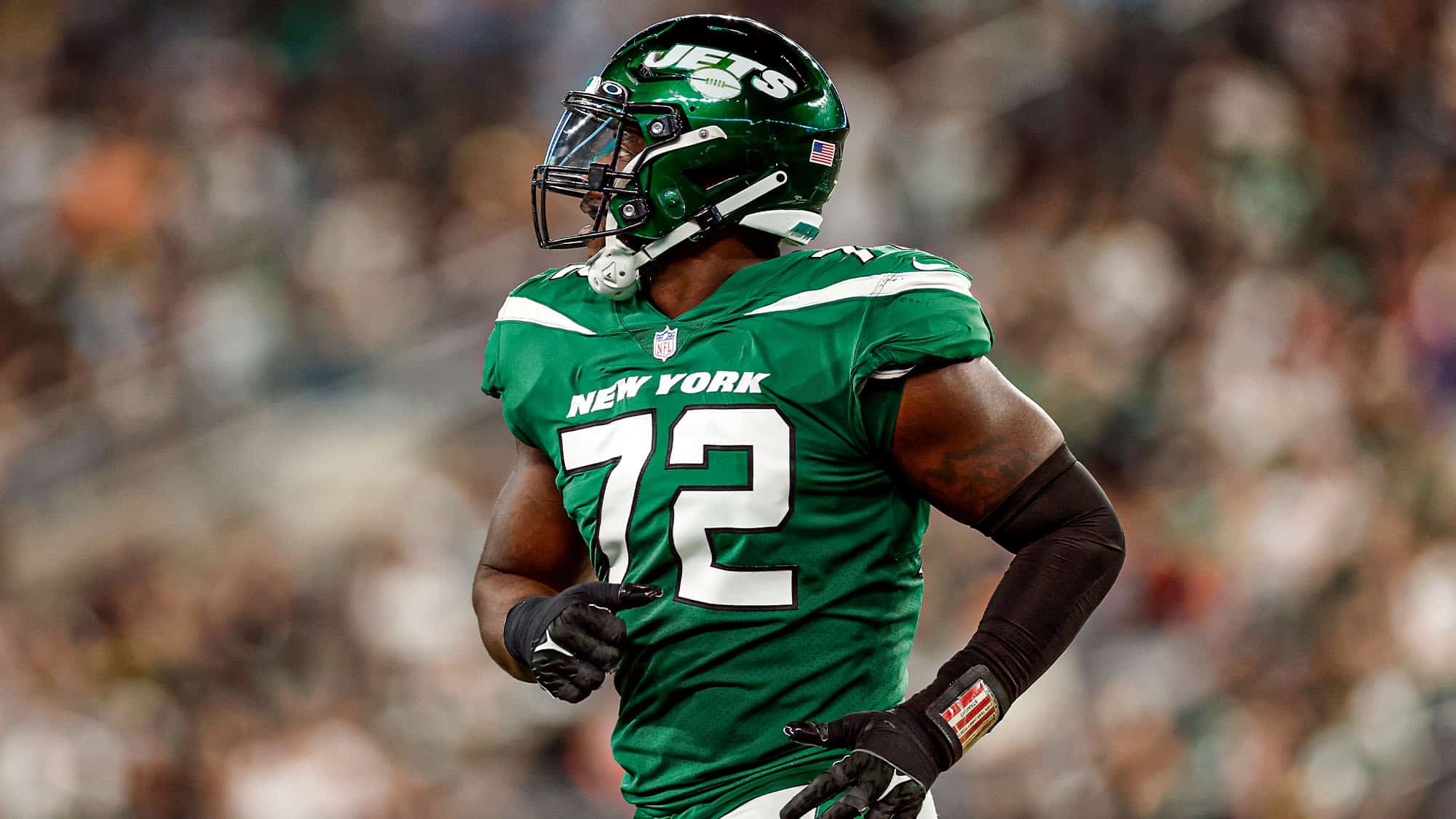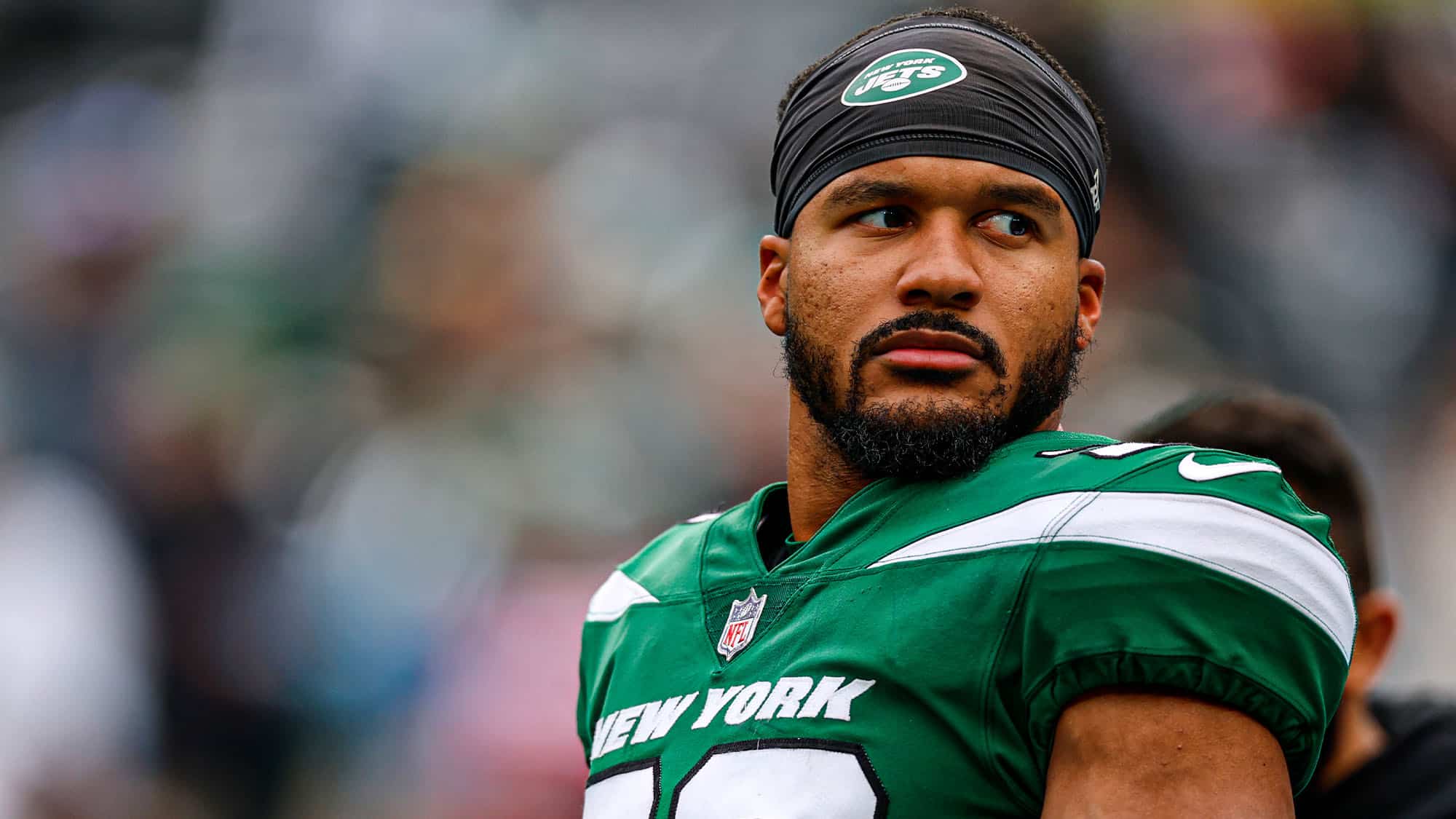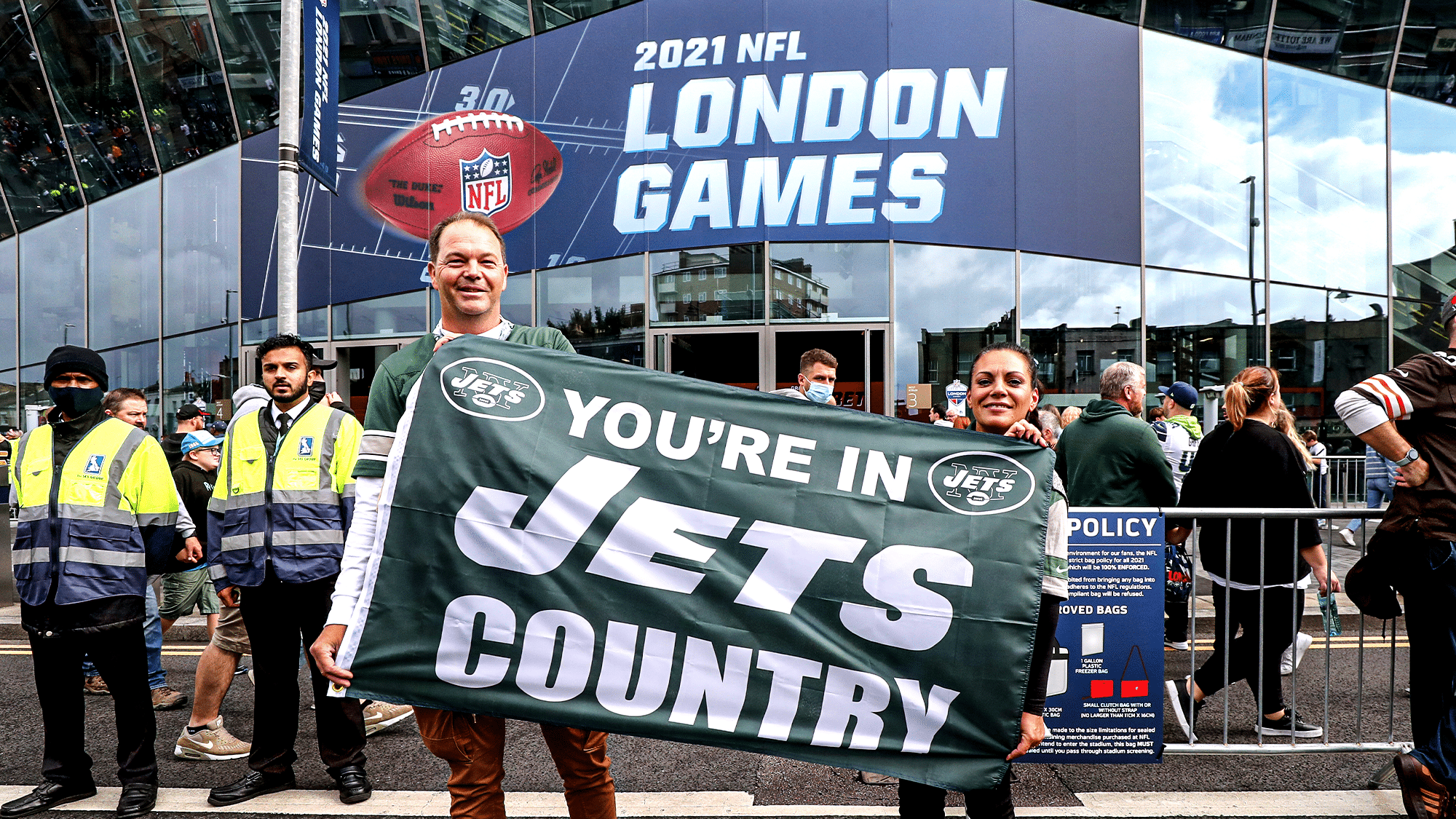New York Jets DE Micheal Clemons bulked up this offseason. How are the results looking so far?
Micheal Clemons already carried the most intimidating frame of any player on the New York Jets‘ roster in 2022. When he showed up to Florham Park for the first time in 2023, he somehow looked even burlier.
We’d later learn that Clemons added 15 pounds in the offseason, increasing his weight from 275 pounds to 290. Defensive coordinator Jeff Ulbrich stated that Clemons’ bulk-up was to prepare him for more reps on the interior of the defensive line.
Three preseason games are in the books. Clemons appeared in two of them. How has the bulked-up Clemons experiment played out to this point?
Well, let’s just say it’s a work in progress.
Clemons has played 44 snaps over two games but doesn’t have much production to show for it. He has been mostly silent despite playing most of his reps against backup offensive linemen.
Clemons is yet to record a sack or a quarterback hit. He only has two tackles and three hurries – two of the three hurries were unblocked, as was one of the two tackles. His pass-rush win rate (via PFF) is a measly 8.0%, ranking 126th out of the 232 defensive linemen to play at least 20 pass-rush snaps this preseason (46th percentile).
Gaudy stats were never Clemons’ bread-and-butter anyway, but even on film, he isn’t popping out in any noteworthy way.
While Clemons is not necessarily playing awfully, he’s merely blending into the crowd amidst a bunch of backups, which is a massive step back from where he was at this point one year ago. In his rookie preseason, Clemons dominated against preseason-level competition, proving he was ready to make plays in the regular season.
In the 2022 preseason (granted, he played 97 snaps, more than double where is currently at this year), Clemons had a sack, two quarterback hits, nine hurries (12 total pressures), six total tackles, and zero missed tackles. The 12 pressures tied for third-most in the league among all defenders. His pass-rush win rate of 13.3% ranked 62nd out of 245 qualified defensive linemen (75th percentile). On film, Clemons backed up his numbers as he constantly jumped off the screen.
Clemons went on to have a solid regular season as a rotational run-stopping edge defender. Playing 19.4 snaps per game with more than half of them coming against the run, Clemons was one of the Jets’ most efficient run defenders. He consistently set a firm edge and rarely (if ever) blew an opportunity to finish a tackle opportunity; PFF credited him with zero missed tackles.
Clemons did not do much damage as a pass rusher (7.2% win rate, 108th of 133 qualified edge defenders), but that wasn’t his role. The Jets simply wanted him to set the edge in run situations, and that’s what he did.
Most likely, the Jets’ primary motivation to increase Clemons’ interior reps was to try and boost his pass rushing production. They probably figured Clemons would have a greater athletic advantage on the inside, where he’d be a relatively small and explosive player for his position as opposed to a relatively big and slow player on the edge.
A decline in run-game production would be the expected cost of increasing Clemons’ interior reps to improve his pass rushing. This would be the natural result of switching from a giant edge defender to a small defensive tackle. However, the Jets likely figured a bulked-up Clemons could hold up respectably enough against the run even as a “small” defensive tackle, considering how strong he is pound-for-pound and how skilled he is in the fundamental aspects of run-stopping.
While these optimistic hypotheses are fair (I myself was a believer in boosting Clemons’ interior reps), there were also some red flags that came with moving Clemons inside, and so far, those red flags are coming to fruition.
Let’s take a peek behind the curtain and see what’s going on.
How has Clemons’ role changed?
While Clemons has not made a full-time move to the inside, Clemons is being used much differently in accordance with his bulk-up. In last year’s regular season, Clemons lined up inside on just 6.8% of his defensive snaps, but so far in this year’s preseason, Clemons is lining up inside on 40.9% of his snaps (18 of 44).
Clemons has not looked impressive when lining up inside. He is yet to record a single tackle, pressure, or pass-rush win on the inside. The film doesn’t do him any favors, as he is not doing the best job of handling his responsibilities beyond the stat sheet, either.
Yes, it’s a very small sample of reps and Clemons is still developing in this new role (although the man is already 26). However, this drop-off makes plenty of sense when you think about the skill set he displayed as a rookie. What Clemons did best was simply use his overwhelming size and strength as an edge defender to dominate tight ends on the strong side edge.
Micheal Clemons is already a beast in the run game. TEs have no chance against him. #Jets pic.twitter.com/haU5204oiQ
— Michael Nania (@Michael_Nania) January 20, 2023
This skill is completely negated when Clemons lines up inside. Clemons can no longer overwhelm smaller opponents. He’s forced to battle toe-to-toe with linemen who are bigger than he is. So far, he has not been up to the task.
When lining up on the edge this preseason, Clemons is still showing glimpses of being the same guy he was last year. It’s the interior reps that are crushing his production and making him seem far less impactful than he was last year.
Here are a few examples of Clemons remaining a force on the edge.
On this play, Clemons (right edge) makes the run stuff after wrecking his way through two tight ends and even a little chip from a WR. It’s possible Clemons could be even more effective in this role than he was last year now that he’s packed on another 15 pounds. Notice how small those tight ends look next to him.
This isn’t necessarily the most impressive play in football history, but coming unblocked off the back side edge, Clemons (right edge) does a nice job of reading the play and positioning himself to defend the cutback. He tosses an unsuspecting lineman out of the way and then makes a clean, hard finish on the RB.
When given a chance to build a head of steam off the edge, I’ve seen Clemons flash a potentially effective bull rush against tackles. This was probably his most notable pass-rush rep of the preseason so far. Clemons (right edge) collapses the pocket and forces a scramble.
Those three reps are reminiscent of Clemons’ rookie year. The problem is that nothing he did in those three plays can be translated to the inside. He cannot bully tight ends, run unblocked off the back side, or build a head of steam from a wide alignment. To win inside, he must be able to work in a phone booth against bigger opponents.
Does Clemons have the skill set to pull that off? It’s fair to wonder whether that is the case.
Clemons still lacks any consistent pass-rush moves beyond a simple bull rush – a move that becomes less effective for him on the inside since he loses his size advantage and often rushes too upright to establish leverage against interior linemen. He sometimes gets away with his upright stance on the edge because he can build a head of steam first, but when working inside, you must have good leverage immediately out of your stance to win with a bull rush, and Clemons can struggle with that (we’ll see examples below).
Because of these limitations, Clemons’ ability to execute with finesse is placed in the limelight whenever he rushes on the inside. We’ve seen in the preseason that Clemons is unable to win in that fashion on a consistent basis.
Clemons tries to beat the LG outside with a cross-chop here, but he telegraphs it, allowing the LG to read it and land his punch in Clemons’ chest. The LG establishes full control of the battle and Clemons gets nowhere near the QB.
Lined up over the LT with Bryce Huff to his outside, Clemons engages the LT and gets locked up for the duration of the rep, showing an inability to counter or shed.
Again lined up over the LT, Clemons slants inside and tries to bull rush the center, but he is way too upright as he engages, minimizing his power and leverage. The center easily absorbs the rush and keeps Clemons far away from the QB. You can see here that even Clemons’ bull-rush technique is raw, and that just won’t cut it against stocky interior linemen who are built low to the ground.
We’ve also seen some shaky reps in the run game.
Lined up between the center and RG, Clemons engages the RG but isn’t aware of the center, leaving his inside half exposed. The center shoves Clemons outside and creates plenty of movement. The RG then does a decent job of keeping Clemons outside to open the inside hole. Clemons crosses the RG’s face and tries to make a play but is too far away to firmly grab the RB, who runs through Clemons’ outstretched arm for a big gain.
Lined up over the LT, Clemons slants inside and takes on the LG. With his hands wide, Clemons’ chest is exposed, and the LG gives him a good pop that knocks him off-balance. If the run went toward Clemons, he would have yielded an enormous play. Luckily, the RB goes the other way and Clemons stumbles directly into him. Clemons does a nice job of trying to recover and make a play (good awareness and good work shedding the block), but he misses the tackle.
Should the Jets move Clemons back to his old role?
If nothing else, Clemons is definitely bringing explosiveness to the inside. Per NFL Next Gen Stats, his average get-off time (how long it takes to cross the line of scrimmage after the snap) when lined up inside is 0.89 seconds, which ranks at the 88th percentile among defensive players with at least 10 interior snaps this preseason. The league average is 1.02 seconds. In the interior clips seen above, Clemons’ get-off speed is noticeable.
That’s all well and good, but the problem is that Clemons isn’t coupling his explosiveness with anything else. He doesn’t have great short-area quickness, fluidity, or flexibility – traits that someone like John Franklin-Myers has, for instance. Those traits are vital for allowing JFM to make his successful edge-to-interior transition on pass plays, but Clemons doesn’t have them. While he is an explosive downhill athlete, he is stiff when it comes to changing directions.
Clemons could work around those limitations if he coupled his explosiveness with a package of effective pass-rush moves. That remains a work in progress right now.
At this point in time, when Clemons lines up inside, he is just an undersized player who can explode off the ball very quickly but doesn’t offer much else.
It’s too early to call this experiment a failure – let’s not get crazy after 18 preseason snaps on the interior (look who’s talking, the guy who just wrote nearly 2,000 words about those 18 snaps) – but there are more reasons to be pessimistic than optimistic about Clemons’ interior outlook at the moment.
Clemons still has a ton of work to do before he can be considered a viable option on the interior. If he cannot show improvement in the next preseason game or throughout the first few regular season games, the Jets might be best served moving Clemons back into his full-time edge role.
I was an advocate of moving Clemons into a hybrid role. It seemed like a potentially beneficial move for not only Clemons himself but for the entire defensive line, as it could help the Jets deal with their logjam on the edge. Every rep Clemons plays inside opens up an extra rep for someone on the edge, whether it’s Will McDonald, Bryce Huff, or Jermaine Johnson.
This is a results-based business, though. If Clemons doesn’t start showing tangible reasons for optimism on the interior, the Jets shouldn’t waste any more time waiting for him to break out. Clemons is 26 years old, after all. Compared to most second-year players, he has significantly less room for growth.
We know what Clemons can do well. He thrived in his role as a part-time edge-setter last season. There’s no shame in falling back on that if the interior experiment does not work out.












I was just talking about Clemons today and wondering if he was offering more production than Thomas. It Seems you have answered my question to a degree. Not really seeing how Clemons or Thomas make there way to the field during the regular season. I Would much rather have JFM Sub on the inside when needed (Which I don’t think will be often). The Edge rotation is going to be nuts this year. So many players that offer different ranges of talent. I’m thinking that who ever is most productive in the early going will receive the most snaps.
Would you have him drop the weight back down to 270’ish if he reverts back to his old role as edge setter? Also, I seem to recall he was decent on special teams last year. Not sure how running at 290+ translates there…